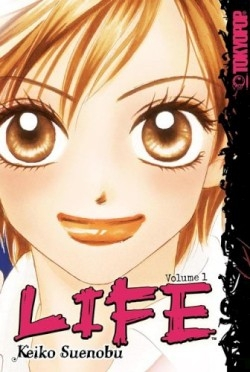
Life Volume 1
Teens can face devastating problems, as readers learn in this graphic novel about “cutting,” or self-injury. Ayumu and top student Shii-chan are best friends in middle school. Shii-chan has always dreamed of getting into Nishidate High School, but Ayumu never cared until she realizes that her inattention to schoolwork could separate the friends. She begins to study, and asks Shii-chan for tutoring.
In her struggle to stay awake and master the material, Ayumu pricks herself with a sharp compass and finds that pain helps her concentrate. Shii-chan fails the test, having spent too much time tutoring Ayumu, who passes, but feels guilt and despair when her friend says, “You were such a burden to me.” Ayumu then punishes herself with a razor. The destroyed friendship prompts Ayumu to try to understand others’ pain; she says of cutting, “As I watched the blood drip … and drip … it was like all the mixed-up thoughts … were flowing out of me.” Her insights and emotions can help readers comprehend self-injury, without reducing it to bizarre behavior worthy of mockery or criticism.
High school’s challenges bring out the blade again. Ayumu struggles to fit in; she fears she’ll hurt new friends as she hurt Shii-chan. Yet Manami won’t take no for an answer, and soon the two hang out together. Manami dreams of marrying her boyfriend, Katsumi, and warns Ayumu away from other girls who try to make friends with her. Ayumu, uncomfortable, wonders if Manami’s controlling friendship is better than being alone.
When Katsumi breaks up with her, Manami tries to commit suicide by standing in front of a train. Ayumu saves her life, and Manami asks why, since she has nothing to live for. Ayumu struggles to understand Manami’s death wish.
Clear, dramatic drawings with lots of bold strokes and subtle shadings evoke Ayumu’s memories of Shii-chan’s friendship, her dilemma over cutting—she knows it’s not healthy, and wonders why it relieves her inner pain—and her desperate lunge to save Manami. The artwork combines a spare, realistic style with the big-eyed faces so well known in manga. Details are achieved with an economy of lines, emotions conveyed through subtle positioning of eyes or limbs.
At the end of the book is a brief informative epilogue by a licensed clinical psychologist about cutting and teen suicide, offering advice and Web references. The information is nonjudgmental and provides an explanation for those who do not understand why people may be driven to this type of behavior. The story itself is told through the eyes of Ayumu, who lives the ordeal and does not judge it.
The author’s previous graphic novel, Vitamin, tells the story of another troubled teenage girl. Life, a popular shojo manga series in Japan, is projected to be a ten-volume series. If subsequent volumes deal as well with the inner conflicts of teens, their young readers should follow through.
Reviewed by
Marlene Satter
Disclosure: This article is not an endorsement, but a review. The publisher of this book provided free copies of the book to have their book reviewed by a professional reviewer. No fee was paid by the publisher for this review. Foreword Reviews only recommends books that we love. Foreword Magazine, Inc. is disclosing this in accordance with the Federal Trade Commission’s 16 CFR, Part 255.
